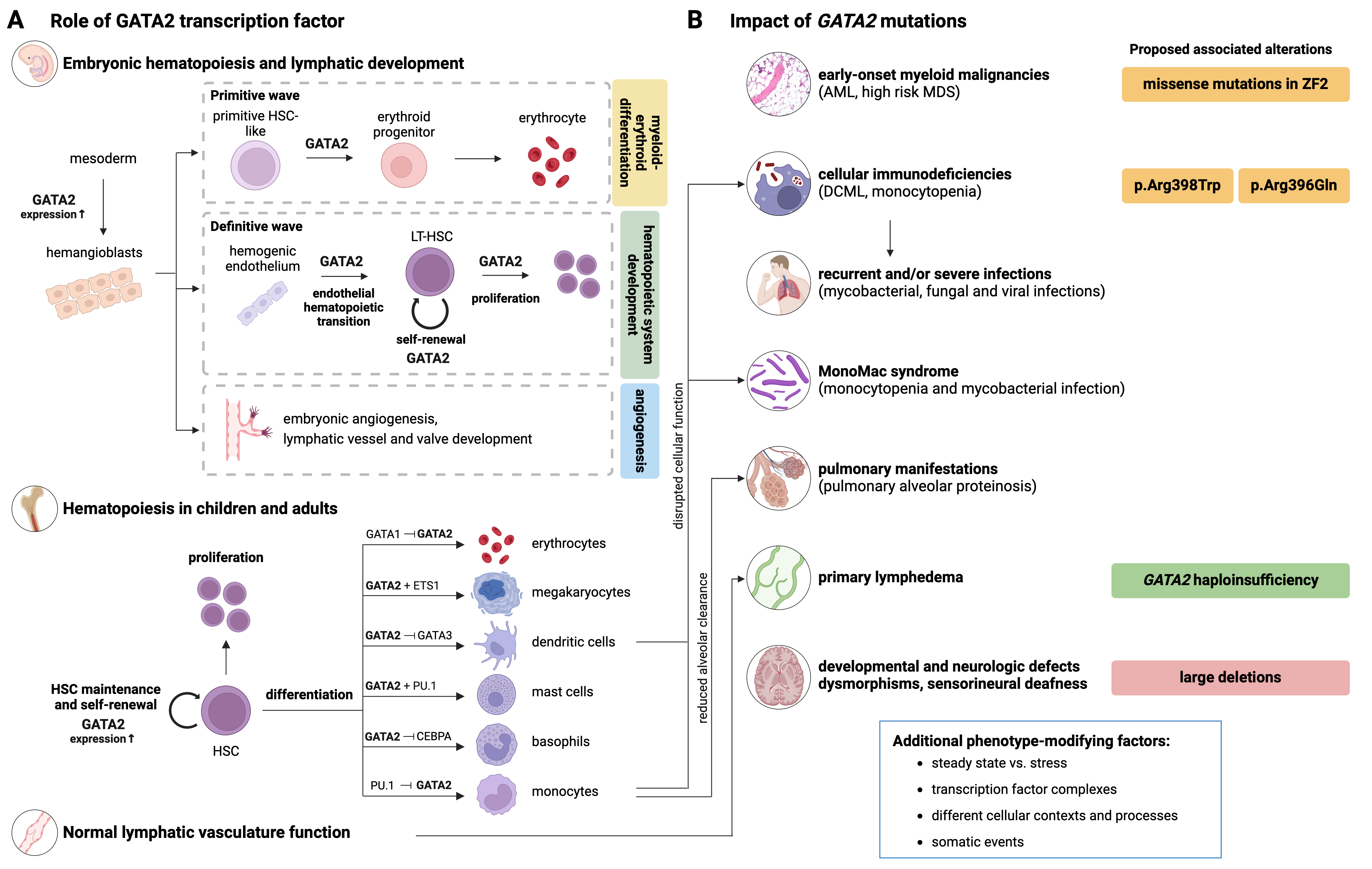What is GATA2 Deficiency?
GATA2 is a key regulatory transcription factor during haematopoiesis, regulating the production of blood cells.
Mutations in the GATA2 gene cause immunologic, hematologic, and vascular diseases.

GATA2 Mutations & Related Diseases
(A) Role of the GATA2 transcription factor during embryonal haematopoietic development and postnatal haematopoiesis.
(B) Impact of GATA2 mutations and phenotype-modifying factors, and clinical phenotypes associated with GATA2 deficiency syndrome.
AML, acute myeloid leukaemia; DCML, dendritic cell, monocyte, B- and NK- lymphoid deficiency; MDS, myelodysplastic syndrome.
Courtesy Lili Kotmayer.
GATA2 has multiple roles during development, from the embryonic stages still in utero to maintaining haematopoiesis and lymphatic vasculature function in children and adults. GATA2 mutations lead to many different symptoms that range from dendritic cells, monocytes and B and Natural Killer cells deficiency (DMLC deficiency or MonoMAC), myelodysplasia (MDS) and/or acute myeloid leukemia (AML), to Emberger syndrome (MDS and lymphedema).
Overall survival of these patients is very poor, reaching 60 to 77% at 40 years and 30 to 45% at 60 years, and life expectancy is limited mainly because of the occurrence of haematological malignancies and immunodeficiency.
GATA2 deficiency is a protean disease with several other phenotypes, including chronic neutropenia (low neutrophil count), bone marrow failure, pulmonary alveolar proteinosis (rare syndrome in which lungs accumulate surfactant, making it harder to breathe), sensorial deafness, neurological features, urogenital malformations, rheumatologic and/or autoimmune features, and miscarriage.

The 3D-GATA2 Approach
Individuals with heterozygous germline GATA2 mutation present with a rare and highly heterogeneous syndrome, frequently with immunodeficiency and an increased risk of malignancies. Although the syndrome can originate prenatally, clinical presentation of GATA2 deficiency is age-specific.
Early diagnosis, personalized care, risk-adapted surveillance and genetic counselling are key to improve patient care.
The 3D-GATA2 project aims to unite the efforts of a large European clinical network, both at national and international levels, to study the cells of GATA2 deficient patients and successfully characterize the natural disease course. This will allow researchers to understand the molecular mechanisms underlying bone marrow failure and malignant transformation, and identify novel biomarkers and therapies.
This knowledge will improve patient outcomes and quality of life, helping future patients with their journey. The ultimate goal of the project is to integrate personalized medicine into care of affected individuals.
Publications
- Pasquet M, Bellanné-Chantelot C, Tavitian S, Prade N, Beaupain B, LaRochelle O, et al. High frequency of GATA2 mutations in patients with mild chronic neutropenia evolving to MonoMac syndrome, myelodysplasia, and acute myeloid leukemia. Blood. 2013 Jan 31;121(5):822–9.
-
- This study identifies a high frequency of GATA2 mutations in patients with mild chronic neutropenia that progress to MonoMac syndrome, myelodysplasia, and acute myeloid leukaemia.
- Kotmayer L, Romero‐Moya D, Marin‐Bejar O, Kozyra E, Català A, Bigas A, et al. GATA2 deficiency and MDS/AML : Experimental strategies for disease modelling and future therapeutic prospects. Br J Haematol. 2022 Nov;199(4):482–95.
- This review explores GATA2 deficiency in myelodysplastic syndrome (MDS) and acute myeloid leukaemia (AML), highlighting experimental disease models and potential therapeutic strategies.
- Solís L, Nordin J, Prevot J, Mahlaoui N, Sánchez-Ramón S, Ali A, et al. The PID Life Index: an interactive tool to measure the status of the PID healthcare environment in any given country. Orphanet J Rare Dis. 2022 Dec;17(1):11.
- This study introduces the PID Life Index, an interactive tool to assess the status of the primary immunodeficiency (PID) healthcare environment in different countries.
- Castaño J, Romero-Moya D, Richaud-Patin Y, Giorgetti A. Generation of two heterozygous GATA2 CRISPR/Cas9-edited iPSC lines, R398W and R396Q, for modelling GATA2 deficiency. Stem Cell Res. 2021 Aug;55:102445.
- This study reports the creation of two heterozygous GATA2 CRISPR/Cas9-edited iPSC lines (R398W and R396Q) for modelling GATA2 deficiency.
- Largeaud, L. et al. Somatic genetic alterations predict hematological progression in GATA2 deficiency. Haematologica 108, 1515–1529 (2023).
- This study identifies somatic genetic alterations as predictors of hematological progression in GATA2 deficiency.
- Sicre De Fontbrune, F. et al. Long‐term outcome after allogeneic stem cell transplantation for GATA2 deficiency: An analysis of 67 adults and children from France and Belgium. Br. J. Haematol. 19691 (2024).
- This study retrospectively reviews the medical records of patients with GATA2 deficiency transplanted in 21 French and Belgium centres until June 2022.
- Largeaud L, Fregona V, Jamrog LA, Hamelle C, Dufrechou S, Prade N, et al. GATA2 mutated allele specific expression is associated with a hyporesponsive state of HSC in GATA2 deficiency syndrome. Blood Cancer J. 2025 Jan 30;15(1):7.
- This study provides a valuable model to study allele-specific expression-related pathology observed in GATA2 deficiency, shedding light on the mechanisms contributing to the disease’s natural progression.

